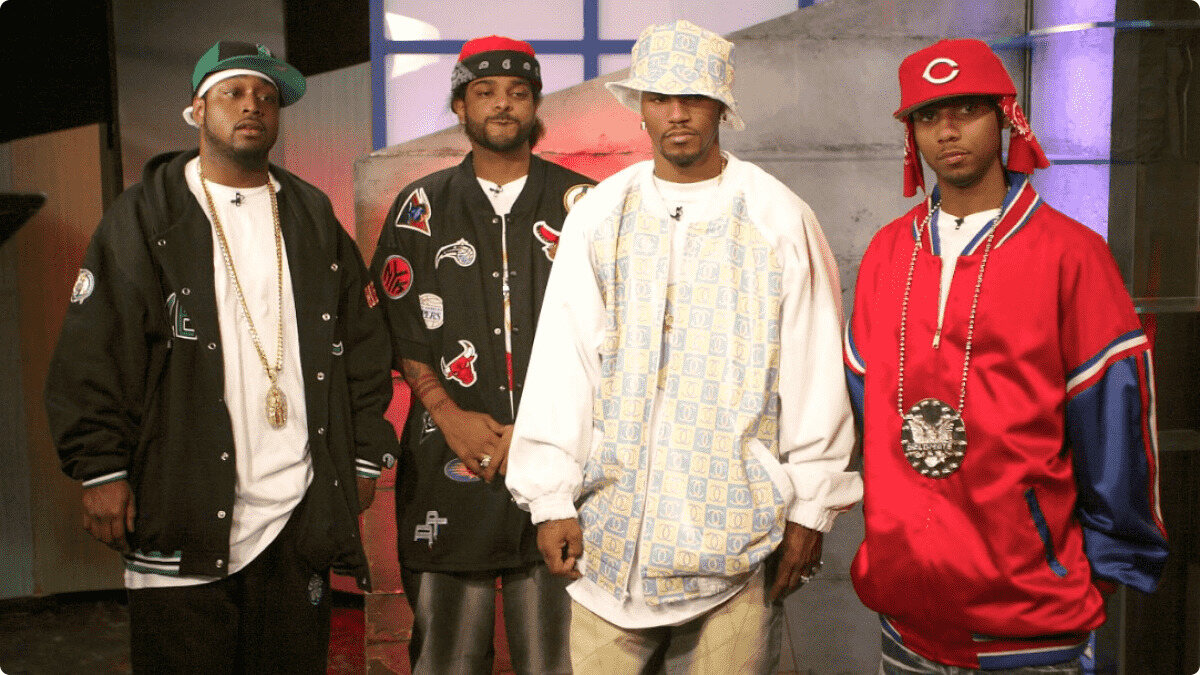

Hip Hop
Why Is It Called Hip Hop
Modified: January 22, 2024
Discover the origins and meaning behind the term "Hip Hop" in this insightful article. Unearth the cultural significance of this dynamic genre and its influence on music and art.
(Many of the links in this article redirect to a specific reviewed product. Your purchase of these products through affiliate links helps to generate commission for AudioLover.com, at no extra cost. Learn more)
Table of Contents
Introduction
Hip Hop is a cultural movement, musical genre, and artistic expression that emerged in the 1970s in the African-American and Latinx communities in the South Bronx, New York City. It has since become a global phenomenon, influencing various aspects of popular culture, including music, fashion, dance, and visual art.
The term “Hip Hop” is often used interchangeably to refer to both the music and the cultural movement surrounding it. However, it’s important to note that Hip Hop encompasses much more than just music. It encompasses a whole way of life and serves as a platform for social commentary, self-expression, and activism.
What sets Hip Hop apart from other musical genres is its unique blend of rhythm, poetry, and storytelling. Combining elements of rap, DJing, graffiti art, and breakdancing, Hip Hop provides a powerful outlet for marginalized communities to voice their experiences, struggles, and aspirations.
Throughout its history, Hip Hop has evolved and diversified, branching out into various sub-genres and styles. From the early days of block parties in the Bronx to the multi-billion-dollar industry it is today, Hip Hop has left an indelible mark on global culture.
In this article, we will delve deeper into the origins of Hip Hop, explore its influences, trace its evolution, examine its cultural impact, and discuss the commercialization of the genre. By understanding the roots and trajectory of Hip Hop, we can gain a greater appreciation for its significance and contributions to the world of music and beyond.
Origins of Hip Hop
The origins of Hip Hop can be traced back to the 1970s in the South Bronx, a neighborhood in New York City. It was a time of social and economic turmoil, with the area suffering from poverty, gang violence, and neglect from the city government.
Amidst this challenging environment, a cultural movement began to take shape. Parties known as block parties became a popular way for communities to come together, socialize, and celebrate. These block parties featured DJs who showcased their skills by playing funk, soul, and disco records.
One of the pioneers of this movement was DJ Kool Herc, a Jamaican-born DJ who is often referred to as the “father of Hip Hop.” Herc is credited with popularizing the technique of “breaks,” where he isolated and extended instrumental sections of songs to create a dance-friendly rhythm.
As the block parties gained momentum, a new artistic expression known as MCing (Master of Ceremonies) or rapping emerged. MCs would engage with the crowd, delivering rhythmic and poetic verses over the beats provided by the DJs.
Graffiti art also played a significant role in the early days of Hip Hop. Many of the young people in the South Bronx used graffiti as a form of self-expression, tagging their names and creating elaborate murals on subway cars and buildings.
Another element that contributed to the development of Hip Hop was breakdancing. Originally known as b-boying or breaking, breakdancing consisted of intricate and acrobatic dance moves that were performed to the beats of Hip Hop music.
The creative energy and sense of empowerment that emerged from the South Bronx during this period laid the foundation for what would become the global phenomenon of Hip Hop. It provided a platform for marginalized communities to tell their stories, express their frustrations, and celebrate their culture.
As Hip Hop spread beyond the Bronx to other communities in New York City and eventually across the country, its influence began to shape the music industry and popular culture. The origins of Hip Hop serve as a reminder of the power of art to emerge from adversity and inspire positive change.
Influences on Hip Hop
Hip Hop is a genre that is deeply influenced by a wide range of musical and cultural elements. These influences have played a significant role in shaping the sound, style, and themes of Hip Hop music throughout its history.
One of the primary influences on Hip Hop is the African diaspora. African rhythms and musical traditions have been part of the fabric of the genre since its inception. The use of drums, rhythmic patterns, and call-and-response techniques in African music have been incorporated into the beats and production of Hip Hop tracks.
Another major influence on Hip Hop is funk music. Artists like James Brown, George Clinton, and Parliament-Funkadelic provided a rich source of inspiration for early Hip Hop producers. The use of funk samples and the incorporation of funky rhythms and basslines became a staple in many Hip Hop songs.
Jazz music is also a significant influence on Hip Hop. Jazz artists such as Miles Davis, John Coltrane, and Herbie Hancock have been sampled and referenced in numerous Hip Hop tracks. The improvisational nature of jazz and its focus on individual expression resonates with the spirit of Hip Hop.
The lyrical aspect of Hip Hop is heavily influenced by poetry and spoken-word traditions. The rhythmic delivery, wordplay, and storytelling found in Hip Hop can be traced back to oral traditions in African culture, as well as the Beat Generation poets like Allen Ginsberg and the Last Poets.
Social and political movements have also had a profound impact on Hip Hop. The Civil Rights Movement, Black Power Movement, and the struggle against systemic racism have shaped the lyrical content and messaging of many Hip Hop songs. Artists like Public Enemy, N.W.A., and KRS-One used their music as a platform for addressing social issues and advocating for change.
Additionally, the technology and musical innovations of the time have influenced the production and sound of Hip Hop. The advent of drum machines, samplers, and synthesizers allowed artists to experiment with new sounds and create unique sonic landscapes. Producers like Dr. Dre, J Dilla, and Timbaland revolutionized Hip Hop production techniques and pushed the boundaries of what was possible.
These various influences have contributed to the rich and diverse tapestry of Hip Hop music. They have allowed the genre to evolve and adapt, staying relevant and resonating with audiences around the world. Hip Hop continues to draw inspiration from both its roots and the ever-changing musical and cultural landscape, ensuring its continuous growth and relevance.
Evolution of Hip Hop
Since its humble beginnings in the South Bronx, Hip Hop has undergone a remarkable evolution, transforming from a local movement into a global phenomenon. Over the decades, the genre has seen changes in musical styles, lyrical content, fashion, and cultural influence.
In the 1980s, Hip Hop gained mainstream recognition with the emergence of artists like Run-D.M.C., LL Cool J, and Rakim. This era, often referred to as the “Golden Age” of Hip Hop, saw a focus on intricate and skillful lyricism. Artists incorporated social commentary, personal storytelling, and wordplay in their rhymes, elevating Hip Hop to a new level of artistry.
The 1990s witnessed further diversification of Hip Hop styles. West Coast artists like Dr. Dre, Snoop Dogg, and Tupac Shakur brought a distinct G-funk sound, characterized by smooth, melodic beats and laid-back flows. Meanwhile, the East Coast saw the rise of hardcore and gritty rap, with artists like The Notorious B.I.G., Nas, and Wu-Tang Clan gaining prominence.
The late 1990s and early 2000s marked a period of commercialization and crossover success for Hip Hop. Artists like Jay-Z, Eminem, and Nelly achieved mainstream popularity, expanding the genre’s reach and influence. This era also saw the emergence of sub-genres such as crunk, trap, and alternative Hip Hop, each with its own unique sound and aesthetic.
In recent years, Hip Hop has continued to evolve and adapt to changing musical trends. Artists like Kendrick Lamar, J. Cole, and Chance the Rapper have brought introspection, social consciousness, and diverse storytelling to the forefront of the genre. The rise of SoundCloud and online platforms has allowed for greater accessibility and independent creativity within the Hip Hop community.
Alongside the musical evolution, Hip Hop has also had a significant impact on fashion and popular culture. From the baggy clothes and sneakers of the 1980s and 1990s to the luxury brands and high-end fashion collaborations of today, Hip Hop has been at the forefront of style trends. The influence of Hip Hop can be seen in everything from streetwear to high fashion runways.
Moreover, Hip Hop has transcended geographical boundaries, with artists from all over the world embracing the genre and infusing their own cultural flavors into their music. From UK grime to African Afrobeat to Latinx reggaeton, Hip Hop has become a global language of self-expression and protest.
The evolution of Hip Hop demonstrates its resilience and ability to adapt to changing times. It continues to push boundaries and challenge societal norms, serving as a powerful voice for marginalized communities and providing a platform for artistic expression and creativity. As Hip Hop continues to evolve, it will undoubtedly leave an indelible mark on the music and cultural landscape for years to come.
Cultural Impact of Hip Hop
Hip Hop’s cultural impact extends far beyond its status as a musical genre. It has influenced and shaped various aspects of popular culture, leaving an indelible mark on music, fashion, language, and social movements.
One of the most significant contributions of Hip Hop is its ability to empower marginalized communities and provide a platform for self-expression. Hip Hop emerged as a voice for African-American and Latinx youth in the South Bronx, who used the medium to express their experiences, frustrations, and aspirations. It allowed a generation to assert their identities and challenge societal norms.
Lyricism in Hip Hop has captivated audiences with its vivid storytelling, wordplay, and social commentary. It has been a vehicle for artists to address issues like systemic racism, police brutality, poverty, and social inequality. Songs like Public Enemy’s “Fight the Power” and Kendrick Lamar’s “Alright” have become anthems of resistance and empowerment.
Hip Hop has also had a profound impact on fashion, influencing trends and styles around the world. From baggy clothes and sneakers to streetwear brands and luxury collaborations, Hip Hop’s fashion influence is undeniable. Artists like Dapper Dan, Pharrell Williams, and Kanye West have shattered barriers between music and fashion, blurring the lines of creativity.
The language and slang of Hip Hop have permeated popular culture, enriching the lexicon of the English language. Words and phrases like “bling,” “homie,” “dope,” and “fresh” have become commonplace. Hip Hop’s linguistic contributions reflect its ability to shape and redefine cultural norms.
Dance is another aspect of Hip Hop that has had a significant impact. Breakdancing, with its acrobatic moves and intricate footwork, has become synonymous with the genre. It has inspired numerous dance crews, competitions, and even its own global event, the Red Bull BC One World Final.
Moreover, Hip Hop has served as a catalyst for social change and activism. Artists like N.W.A. and Tupac Shakur denounced police brutality and advocated for racial justice. Hip Hop has been instrumental in raising awareness about social issues and mobilizing communities to take action.
The reach and influence of Hip Hop have expanded beyond the United States, infiltrating cultures around the world. From the UK’s grime scene to Brazil’s baile funk to South Korea’s K-pop influenced Hip Hop, the genre has become a global phenomenon, transcending linguistic and cultural barriers.
In its essence, Hip Hop represents a movement that empowers individuals, encourages self-expression, challenges societal norms, and uplifts marginalized voices. Its cultural impact continues to shape our understanding of creativity, identity, and social change, making it one of the most influential cultural phenomena of our time.
Commercialization of Hip Hop
As Hip Hop gained popularity and mainstream recognition, it underwent a process of commercialization that transformed it into a multi-billion-dollar industry. The commercialization of Hip Hop has brought both opportunities and challenges, shaping the way the genre is consumed, produced, and marketed.
In the early days of Hip Hop, artists and labels operated independently, with a DIY mentality. They relied on grassroots promotion, mixtapes, and live performances to reach their audience. However, as the genre started to attract attention from major record labels, the commercial potential of Hip Hop became evident.
The commercialization of Hip Hop brought increased accessibility and exposure for artists. It allowed them to reach larger audiences and gain financial success. Record deals, endorsements, and brand partnerships became common, providing artists with new revenue streams and opportunities for mainstream success.
However, as Hip Hop became more commercialized, concerns about authenticity and artistic integrity arose. Some argued that the commercialization of the genre led to the homogenization and dilution of its core messages and cultural significance. Mainstream success often required artists to conform to industry standards and compromise their artistic vision.
Another criticism of the commercialization of Hip Hop is the reinforcement of negative stereotypes. As record labels looked to capitalize on the genre’s popularity, some artists and media outlets focused on promoting and exaggerating certain aspects of Hip Hop culture, like violence, materialism, and misogyny, while neglecting the more nuanced and positive elements.
The commercial success of Hip Hop also gave rise to a divide between underground and mainstream artists. Some artists who maintained their independence and refused to conform to commercial pressures were relegated to the underground scene, while those who embraced commercial success gained greater visibility but were seen by some as sellouts.
Furthermore, the commercialization of Hip Hop has had a significant impact on the industry’s power dynamics and distribution of wealth. Despite the genre’s immense financial success, many artists, particularly those from marginalized backgrounds, continue to face exploitation and inequitable treatment within the music industry.
However, it is important to acknowledge that commercialization has also provided opportunities for artists to build sustainable careers, amplify their voices, and create positive change. It has allowed for the rise of independent labels, entrepreneurship, and the ability to control one’s creative output.
The commercialization of Hip Hop is a complex phenomenon with both positive and negative consequences. While it has undoubtedly opened doors for many artists and expanded the reach of the genre, it has also raised important questions about authenticity, representation, and the commodification of culture. As Hip Hop continues to evolve, it is crucial to strike a balance between commercial success and preserving the cultural essence and integrity of the genre.
Conclusion
Hip Hop is more than just a genre of music; it is a cultural movement that has had a profound impact on society. From its origins in the South Bronx to its global reach, Hip Hop has become a powerful force of self-expression, social commentary, and artistic innovation.
The origins of Hip Hop in the South Bronx represent a testament to the resilience and creativity of marginalized communities. It provided a platform for individuals to voice their experiences and navigate through challenging social and economic circumstances.
Throughout its evolution, Hip Hop has been influenced by a diverse range of musical genres, cultural traditions, and social movements. It has incorporated elements of funk, soul, jazz, and spoken-word poetry while reflecting the social and political climate of different eras.
Hip Hop’s cultural impact goes beyond music. It has influenced fashion trends, language, dance forms, and has served as a catalyst for social change and activism. It has given a voice to marginalized communities, raising awareness about social issues and advocating for equal rights and justice.
The commercialization of Hip Hop has brought both benefits and challenges. It has allowed for greater accessibility, exposure, and financial success for artists, but also raised concerns about artistic integrity, representation, and the perpetuation of negative stereotypes.
As Hip Hop continues to evolve, it remains a powerful means of self-expression and cultural exploration. It has transcended geographical and cultural boundaries, uniting people from diverse backgrounds through its rhythmic beats, poetic storytelling, and unapologetic authenticity.
In conclusion, Hip Hop’s enduring influence and cultural impact cannot be denied. It has reshaped the music industry, broken barriers, and inspired generations of artists and activists. It is a movement that continues to redefine cultural norms, challenge social injustices, and provide a voice for the marginalized. Hip Hop’s journey is a testament to the power of art, unity, and the human spirit.











